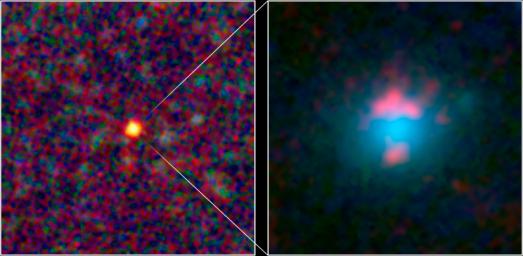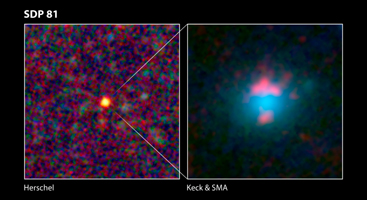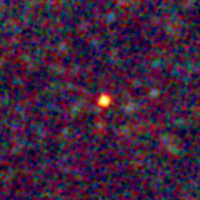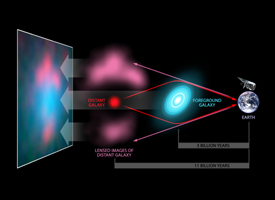Click on an individual image for larger viewThis image composite shows a warped and magnified view of a galaxy discovered by the Herschel Space Observatory, one of five such galaxies uncovered by the infrared telescope. The galaxy -- referred to as "SDP 81" -- is the yellow dot in the left image taken by Herschel. It can also be seen as the pink smudges in the right image, a composite of ground-based observations showing more detail.
Herschel was able to find the galaxy, which is buried in dust, because it happens to be positioned behind another galaxy (blue blob at right), which is acting like a cosmic lens to make it appear brighter. The gravity of the foreground galaxy is distorting and magnifying the distant galaxy's light, causing it to appear in multiple places, as seen as the pink smudges. The distant galaxy is so far away that its light took about 11 billion years to reach us.
Herschel couldn't detect the foreground galaxy, but astronomers were able to spot it in visible light using the W.M. Keck Observatory. Several follow-up observations by ground telescopes helped to get a better view of the distant galaxy. For example, the pink smudges at the right show wavelengths that are even longer than what Herschel sees in the submillimeter portion of the electromagnetic spectrum. Those observations were made by the Smithsonian Astrophysical Observatory's Submillimeter Array in Hawaii.
Herschel is a European Space Agency cornerstone mission, with science instruments provided by consortia of European institutes and with important participation by NASA. NASA's Herschel Project Office is based at NASA's Jet Propulsion Laboratory, Pasadena, Calif. JPL contributed mission-enabling technology for two of Herschel's three science instruments. The NASA Herschel Science Center, part of the Infrared Processing and Analysis Center at the California Institute of Technology in Pasadena, supports the United States astronomical community. Caltech manages JPL for NASA.

 Planetary Data System
Planetary Data System















